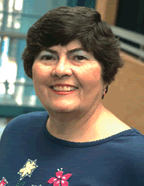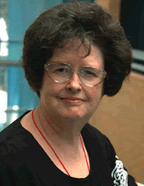High School Chums Share Alma Mater and Workplace
Since the 1960s, Perry and Ford have both worked in the Pollak Library
August 27, 2007
By Pam McLaren
In among the reference books, magazines, computers and historic objects housed in the Pollak Library are two women who began a friendship as members of a high school library club that continues to this day.
Linda Ford, coordinator of acquisitions and database services and collection development librarian, joined Cal State Fullerton and the library staff in 1967, and later went on to earn a bachelor’s degree in history in 1976 and a master’s in library science in 1978. Sharon Perry, university archivist and special collections librarian, attended CSUF as a student for four years, earning a bachelor’s in history in 1968, then spent a year at UCLA working on a library degree before returning to her alma mater as a junior librarian.
Both long-time employees stress that they enjoy their job — “even after 40 years,” says Ford — and hope that they make a difference for faculty, staff, students and campus visitors.
“I find it intellectually stimulating and a lot of fun. I believe I provide a useful service to my patrons and they seem appreciative of my efforts. I have always had interesting and intelligent colleagues,” says Perry. “I have never thought of working anywhere else.”
“I have relished interacting with a wide variety of people whose subject interests and research pursuits have covered a very broad spectrum. Interesting people have really stimulated my ever-changing connection/relationship with the Pollak Library,” says Ford.
After working in school libraries since seventh grade, it seemed almost natural for Ford to enroll in Fullerton College’s new library technician program after high school. Then, she heard that Cal State Fullerton’s library was looking for volunteers.
“Consequently, I was one of the first volunteers in the now-Pollak Library and worked in two different sections, acquisitions and cataloging, at the beginning of 1967,” Ford says. “When someone went on maternity leave, I was asked if I wanted a temporary position in the acquisitions section. This eventually became a permanent position that I applied for and was hired in July 1967.
“When I first started working on campus we had what would now be considered rigid dress codes,” says Ford. “All the women had to wear dresses or skirts; no pants were allowed. Some of our students even brought dresses to change into when they came to work in the library. In the midst of a particularly cold winter, we received permission to finally wear pants and never looked back.”
Sharon Perry’s earliest memories of the campus come from her student days— and are not that different from students to this day.
“The parking on the first day of each semester was always a nightmare. I never allowed enough time to arrive on campus, find a space and get to my classes,” she remembers. “I was always rushed. I may be one of the few people on campus that believes that parking is quite nice on campus now with the faculty-staff lots and the parking structures.
“Of course, my husband, who is retired, brings me to work and picks me up almost every day, so that may play a role in my point of view,” she notes.
“I also remember the first library, which was in the basement of what is now McCarthy Hall, but was then know as the Letters and Science Building. My studying was often distracted by the sludge that ran through the clear see-through sewage pipes in the ceiling of the basement.”
A year after graduating from campus, Perry was back and seeking a job at the university library. “Things were simpler then. Mr. Ernest Toy, the founding university librarian, interviewed me on the spot and gathered up the Public Services recruitment committee, who also interviewed me on the spot.”
A week later, Perry received an employment offer for a full-time, tenure-tract position in the reference section to begin in July. “I was hired as a junior librarian, which is no longer a rank used, with a monthly starting salary of $720. I have been here ever since.”
Perry says her best memories are of the “kindness of my many professors, some of whom are still on campus” and the “graciousness and patience of my colleagues when I began my work as a brand new librarian. They were my mentors and helped shape me as a librarian.”
Many of Ford’s campus memories revolve around events, such as attending team handball matches on campus during the 1984 Olympics. “As a smaller campus in the early ’70s, when we celebrated Secretary’s Day, the entire campus staff was always invited to lunch at an of-campus restaurant,” says Ford. “For the holidays it was always gratifying to visit the President's Office and stand on the ninth floor balcony to look out on the wonderful view across Fullerton. You always hoped it would be a clear day so that you could see almost to Newport Beach.”
Perry also remembers those days when the campus and library were smaller and “everyone knew each other throughout the building, regardless of the section or department one was in,” she says. “It was a wonderful hard-working community but we had wonderful parties too at lunch-time, after work and on weekends.”
Ford was on campus for the two visits by Ronald Reagan, first as the governor of California and then as president of the United States. “The first visit led to some scary protests and confrontation by the police. Several of us were off campus for lunch and came back surprised to see helicopters flying overhead and loudspeaker announcements requesting that we stay inside campus buildings while helmeted police officers attempted to maintain crowd control. On his second visit it was a very patriotic crowd with everyone waving miniature flags that had been passed around.”
Something that has remained with Ford for a long time is from the early days of the campus ROTC program. She was working in the library and “heard a tremendously loud noise while at the same time seeing trees bending almost in half though there was no wind outside. Suddenly, a military helicopter landed on the grass right next to the library surprising everyone as prior permission to land had not been requested. Naturally, we all rushed out to catch a close up view.”
Ford also remembers physical changes. “I miss the bridge that crossed over Nutwood Avenue that led at various times to a bookstore, bank, department store and restaurants before the property became Pacific Christian College (now Hope University).”
For Perry, the growth of the campus, its programs and its faculty, staff and student populations are among the biggest changes she has seen on campus.
“I walk just about every day on campus (looking for ephemera for the university archives and keeping current on services and locations so that I can provide accurate information at the reference desk) and I am always amazed at the varying activities I see — athletes on the “playing fields of Eton”; dancers in their leotards running just a little late for dance class; conscientious community service officers ticketing parking offenders; sweet toddlers from the children’s center in their cute little red wagons on a field trip to the David statue; grounds men keeping the trees, shrubs, plants and flowers in apple pie order; community visitors enjoying the beauty and serenity of the Arboretum and busy students with their laptops studying everywhere or talking on their cell phones.”
Ford sees the biggest changes coming from technology, “that have helped to enhance student and faculty access to information.”
“When the old paper card catalog — whose entries had to be typed and then manually filed in dozens of drawers — was done away with in 1989, it was a tremendous relief for everyone, but mostly for those who had to come to the catalog in order to thumb through the printed and typed catalog cards. This information is now readily available to the CSUF community from any convenient desktop or laptop.
“Certainly the onset of email has made long telephone calls across state lines much less common. But the introduction of electronic databases, journals and e-materials has radically revolutionized how the library interacts with the rest of the campus and with the outside world. Back files of paper journals and various out-of-print books that we could never have afforded are now available from a variety of sources, in a number of formats, which can often be transmitted to the PC of the individual who is researching a particular topic. These changes, in turn, have fundamentally changed the library staff structure and its operation to meet ever-changing information needs.”
What does the future hold for these two colleagues and friends?
“I plan to retire in five to seven years,” admits Perry. “I will be in a transition period but I am sure my personal interests in reading, film, theater and travel will continue. I hope the university continues to thrive but I would like to see a period without construction on campus so that we can enjoy the new facilities and still have some open space on the campus.”
Ford has no such plans for retirement and in fact, hopes to continue working for several more years. An experienced traveler who has visited all seven continents, including Antarctica earlier this year, Ford is busy planning future travels, as well as fitting in as much theater as time permits. “Even after 40 years, I thoroughly enjoy my job and hope that I have made a difference in building our collections to support our faculty needs and support the curriculum taught on the campus.”


